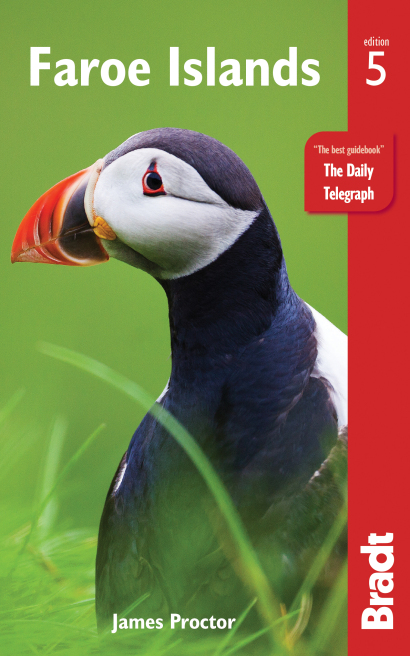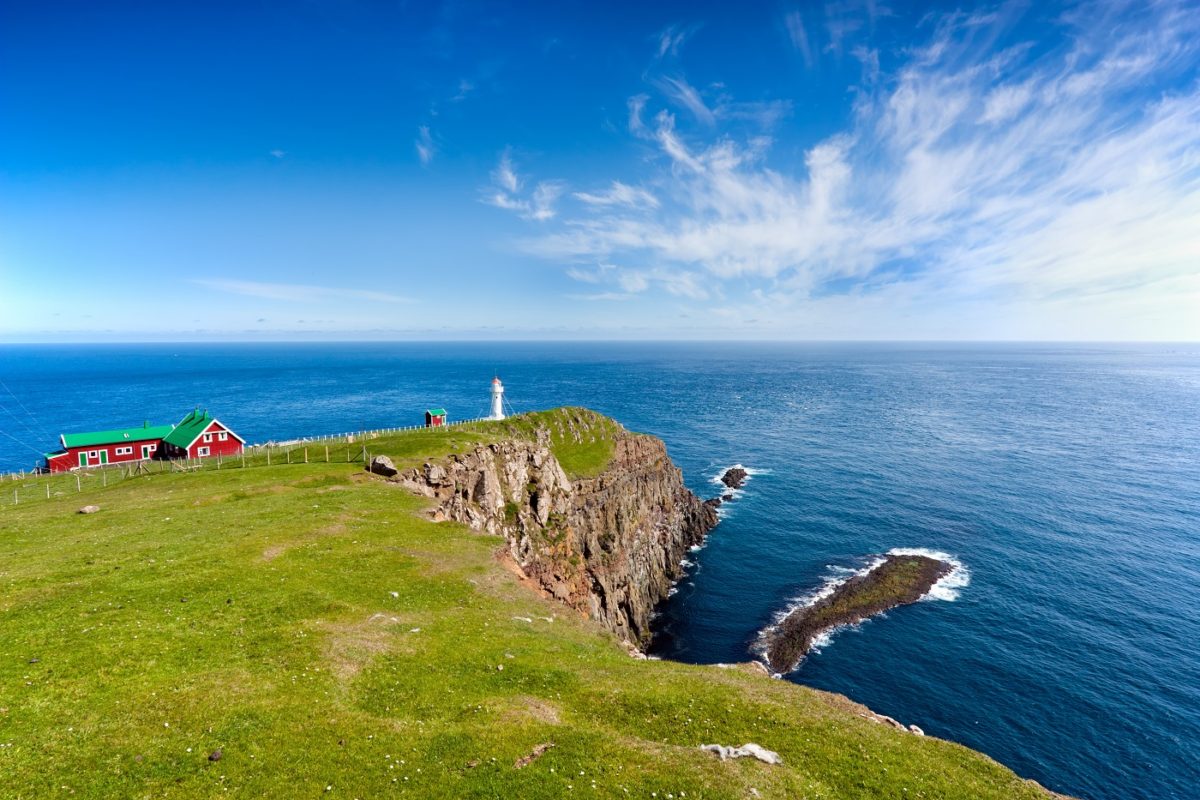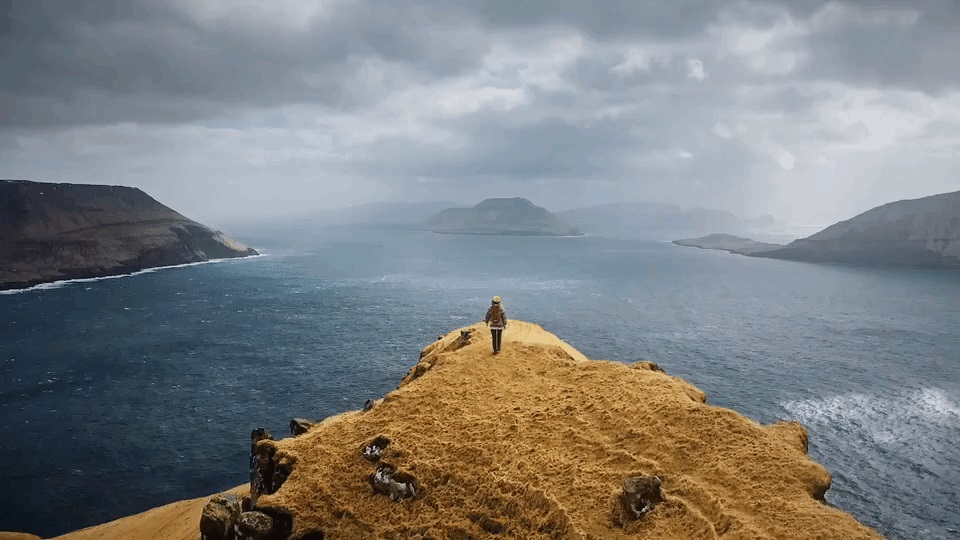Arguably best known for their dramatic appearance in the BBC shipping forecast, the Faroe Islands are still one of Europe’s best-kept secrets.
James Proctor, author of Faroe Islands: the Bradt Guide
Wild, wet and windy, these 18 volcanic islands, far out in the North Atlantic, are a different world – a realm of austere beauty where crystal-clear mountain streams cascade down verdant hillsides dotted with turfroofed homes, their timber walls painted a mêlée of reds, yellows and blues; a world where sea cliffs, teeming with birdlife, plummet precipitously into the churning Atlantic below; a world where the sea is all-powerful, giving and taking away.
This geographically isolated land of towering layer-cake mountains and deep rounded valleys, sparkling fell-top tarns and shorelines gnawed into countless craggy inlets is of such elemental wonder that first-time visitors soon become ardent devotees, returning time and again to the Faroes, one of Europe’s last places.
Agreed, the weather can be unreliable, even downright inclement at times – but the good news is that conditions in the middle of the Atlantic change fast, so you’ll never have long to wait for a glimpse of the sun. There’s sound logic behind the Faroese saying: ‘If you don’t like the weather, wait five minutes!’
The quality of the light in the northern sky, which attracts countless artists to the islands, and the purity of the air are perhaps two of the most difficult things about the Faroes to qualify on paper – visit, though, and you’ll soon appreciate this most alluring side of island life.
Thanks to regular air links to several European countries and a well-appointed ferry plying the waters of the North Atlantic, it has never been easier to reach the Faroe Islands.
Whether you’re looking to hike across tussocky moorland landscapes to imposing lighthouses perched on rocky promontories, watch seabirds in their natural habitat atop vertical cliff faces or simply island-hop around the Faroes exploring traditional villages and hamlets as you go, you’re sure to find an itinerary to please.
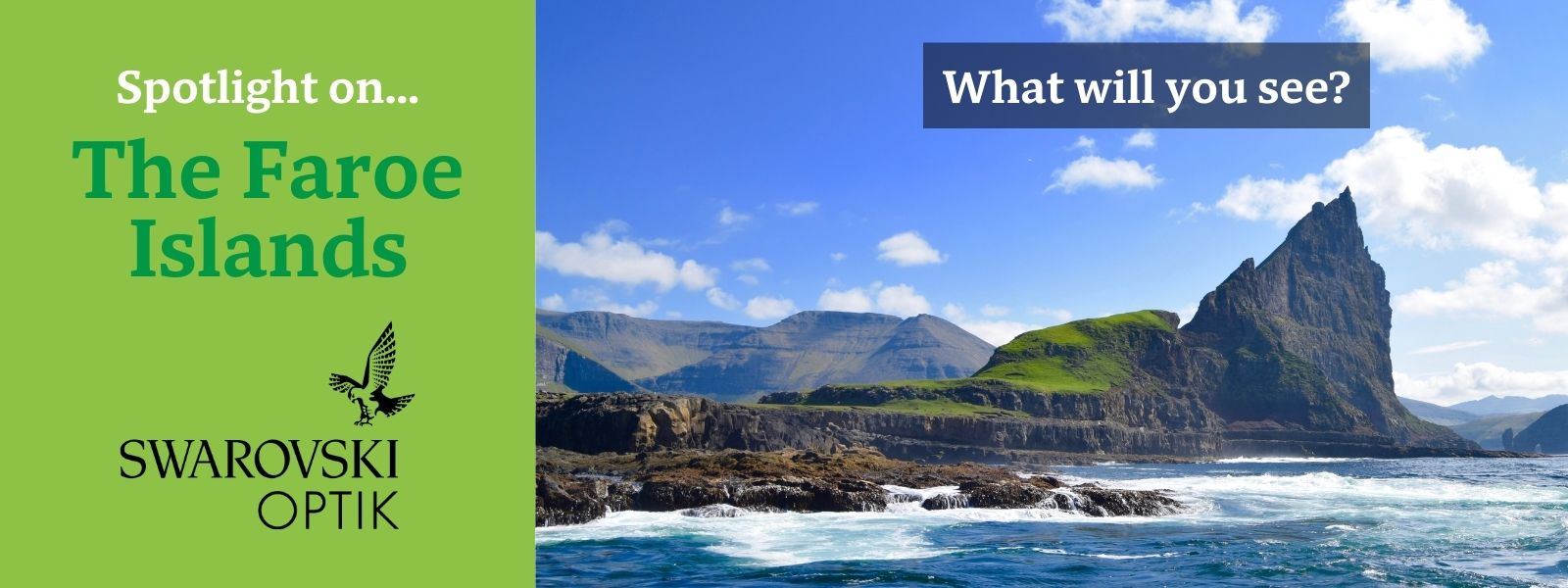
Food and drink on the Faroe Islands
Similarly to accommodation, the greatest choice of eating and drinking establishments can be found in Tórshavn where you will find everything from Burger King to sumptuous smorgasbord spreads of every Faroese and Nordic delicacy you care to imagine, generally served in the hotels.
In the smaller villages, though, it can often be difficult, if not impossible, to find somewhere to eat and you may well find yourself backtracking to the nearest main village to get some food. While out in the sticks, you can always rely on filling stations to hold a small selection of sandwiches and to serve up hotdogs with mustard (always very good and not nearly as tasteless as you may think) and sometimes chips.
If the worst comes to the worst, look for a supermarket and go self-catering (remember, though, most supermarkets are closed on Sunday); there’s generally some kind of food store in all but the smallest of villages. On board the larger ferries (operating on the routes Tórshavn–Suðuroy and Gamlarætt–Skopun), there are cafeterias serving snacks and coffee. For a more personal dining experience, ask the tourist office about Dining with the locals or heimablídni as it’s known in Faroese, an opportunity to meet local people and eat with them at home. Naturally, times and locations are subject to change but you can find more details at visitfaroeislands.com/see-do/dining/heimablidni and the tourist office will have the latest information.
Faroese breakfast, as served in the hotels in Tórshavn, and less extravagantly elsewhere in the country, is a Scandinavian-style cold table of hams, cheeses, herring, cereals, yoghurts, fruit and sometimes Danish pastries. It’s a help-yourself affair and you’re permitted to take as much as you like and visit the table as many times as you like. There are also limitless supplies of coffee, tea and juice.
The main meal of the day in the Faroe Islands is lunch, which, in Tórshavn at least, throws up a variety of options. Once again, an extremely good-value help-yourself buffet where you can eat your fill for around 150kr is a decent option. Lunchtime in the Faroes is any time between about 11.00 and 14.00, though most people tend to eat around noon or 13.00. If you’re looking to save money while in the Faroes, switch your main meal of the day to lunchtime and you’ll save a packet – have a snack in the evening instead, bought from the supermarket or bakery, and you’ll make your money go much further.
Dinner can be expensive for what you get – meals are often heavily meatorientated (rather than fish-based) with an accompaniment of (more often than not) overcooked vegetables and masses of potatoes. Sadly, due to the lack of fresh vegetables in the islands, many eateries serve veggies straight out of a can. Frustratingly for a country so influenced by the sea, it can be hard to find fresh fish on the menu. You should count on around 250–350kr for an upmarket two-course restaurant dinner, though of course you can eat in the pizzerias and cafés of Tórshavn for around half of that.
While in the Faroes it’s worth searching out and sampling some of the islands’ traditional foods. A particular favourite is wind-dried sheep’s meat, skerpikjøt, prepared around Christmas time and then nibbled throughout the year; virtually every home in the islands has its own hjallur or meat-drying outhouse. Pilot whale meat and blubber is occasionally also available on the menu (particularly at a Faroese evening or sometimes on the Faroese smorgasbord served up during the summer at Hotel Hafnia in Tórshavn) though it is somewhat of an acquired taste. Look out too for roast lamb and boiled wind-dried fish, ræstur fiskur – two other delicacies. Popular fish dishes (should you be able to find them on the menu) include haddock, halibut, plaice and salmon.
What will push the bill up is alcohol; a bottle of wine is roughly around 250kr, a draught beer usually starts at 60kr. It’s much cheaper to do your drinking at home – which is what many of the Faroese do.
Buying alcohol
Owing to a strong temperance movement (and religious objections), alcohol has only been (relatively) freely available in the islands since 1992. Before then the Faroes practised a system of public prohibition and every bottle of the hard stuff (including wine) had to be shipped in from Denmark and was doled out in rations.
Mercifully, the Faroes have now entered the modern age and alcohol is more readily available – albeit restricted by some bizarre legislation. Forget any notion of nipping into the nearest supermarket to buy a bottle of wine for dinner because alcohol is not available in the shops. The only place to buy any form of alcohol, be it strong beer, wine or spirits, is Rúsdrekkasøla Landsins (known colloquially as rúsan) a state-run monolith responsible for all-things alcoholic.
Opening times are limited and you’ll find only six of these liquor stores in the entire country; they’re located in Klaksvík, Miðvágur, Saltangará, Skálavík, Tórshavn and Drelnes. In short, if you’re heading out into the wilds, stock up before you leave town or you’ll be left with the pathetically weak fizzy beverage sold in supermarkets, ljóst pilsnar, purporting to be beer yet with an alcohol content of barely 2.8%.
Health and safety on the Faroe Islands
Health
The health risks while travelling in the Faroe Islands are minimal and healthcare is of an excellent standard. Language is rarely a problem and health workers are generally proficient in English. However, should you encounter any communication problems, the local tourist office should be able to point you in the direction of a doctor or dentist who does speak English.
Under Faroese law, a national of any country is entitled to emergency healthcare in the case of an accident; it is the responsibility of the individual doctor treating you to decide just what ‘emergency care’ consists of. If, however, you suffer from a medical condition requiring regular treatment or medication, this is not free and you will have to pay for all treatment received. It is necessary to present your passport at the hospital to receive any form of emergency care. It goes without saying that you should have comprehensive travel insurance.
As far as safety is concerned, the main risks are the Faroese landscapes – vertical sea cliffs that drop into the sea from heights of up to 900m should obviously be approached with great care. It’s also important to remember that when you’re out in the countryside the weather can change at any moment and hiking conditions can very quickly become hazardous; however, with common sense, it’s unlikely you’ll encounter serious danger. In relation to crime, the Faroes are one of the safest parts of the world you will ever visit: police figures put the yearly number of break-ins and cases of theft at barely 500 for the entire country.
Travel clinics and health information
A full list of current travel clinic websites worldwide is available on www.istm.org. For other journey preparation information, consult www.travelhealthpro.org.uk (UK) or http://wwwnc.cdc.gov/travel/ (US). Information about various medications may be found on www.netdoctor.co.uk/travel. All advice found online should be used in conjunction with expert advice received prior to or during travel.
Safety
Female travellers
Women travelling alone are unlikely to encounter any problems. Faroese males are generally well mannered and far too shy to create trouble. On Friday and Saturday nights in Tórshavn, when the beer starts to flow, it’s obviously sensible to keep your wits about you but, once again, you’re unlikely to become the target of abusive behaviour.
LGBT Faroes
Quite remarkably for a country where religion is still widely respected (and feared), there has been a sea change in attitudes towards homosexuality. In 2006 it became illegal to discriminate on the grounds of sexual orientation following a change in the law.
The new legislation was prompted by a well-publicised gay-bashing incident on a well-known musician in a pub in Tórshavn which appalled the public. More recently, in 2012, a staggering 5,000 people (10% of the population) marched through the streets of Tórshavn during Faroe Pride, calling for gay marriage to be legalised in the islands, in line with the law in Denmark.
Faroe Pride is now an annual event and is undoubtedly the best time for any gay traveller to visit the islands; it’s held on 27 July, the day before Olavsøka. For more information about the Faroese gay scene, check out lgbt.fo or its Facebook page.
The islands’ first out gay MP, Sonja Jógvansdóttir, was elected to parliament in September 2015 and same-sex marriage was finally made legal in July 2017 following several failed attempts a few years earlier. A public opinion poll conducted ahead of the change in the law showed around two-thirds of the population in favour; as expected, support was strongest in the area around Tórshavn and among the younger generation in general.
Travel and visas on the Faroe Islands
Getting there and away
By air
The quickest and easiest way to reach the Faroe Islands is by the Faroese national airline, Atlantic Airways, which operates all but one route to the islands. The international airline code for Atlantic Airways is RC and the airport code for the Faroes is FAE. Scandinavian Airlines also operates from Copenhagen to the Faroe Islands, making connections to the Faroes from across its network possible via the Danish capital.
The airport is located on the island of Vágar, just outside the town of Sørvágur, and is connected to Tórshavn by bus and taxi. Presently, it contains a café, ATM, tourist information desk and car-hire outlets before security, and a café and duty-free airside. The airport is also used as the departure point for the Atlantic Airways helicopter service, which serves the islands.
From the United Kingdom
Atlantic Airways operates directly from Edinburgh (EDI) to the Faroes twice a week (on Thursdays and Mondays) all year round, although services are reduced during the winter months. Flying time is in the region of 1 hour. When there is no flight from Edinburgh, connections can be made via Copenhagen.
From mainland Europe
An option that suits travellers coming from mainland Europe is to travel via Denmark with either Atlantic or SAS, which both offer daily flights from Copenhagen; connections to the Danish capital are available with most major European airlines. CPH–FAE return fares start at around 1,250 Danish kroner. Book early for the cheapest fares.
From the United States
The best way to reach the Faroes from the USA is to travel via Reykjavík with Icelandair (airline code FI) or via Copenhagen with SAS. Flying with Icelandair, you’ll sometimes need to change airports in Iceland; Icelandair flights arrive at the main international airport, Keflavík (KEF), and onward Atlantic Airways flights to the Faroes (1hr) usually leave from Reykjavík city airport (RKV); both airports are linked by transfer bus.
From Canada
Icelandair operates from several Canadian gateways (check the Icelandair website for the latest details) to Reykjavík, or pick up a flight to one of Icelandair’s US gateways and transfer there for Iceland and then on to the Faroes. Alternatively, fly with Air Canada to Copenhagen and then up to the Faroes.
From the rest of the world
Getting to the Faroes from the rest of the world naturally involves first reaching either London or Copenhagen, from where connections are available as described above. It’s worth checking online travel websites, such as Kayak or Momondo, for any special deals that might include the final leg with either SAS or Atlantic Airways up to the Faroes.
By sea
The Faroese-operated Smyril Line connects the islands with Hirtshals in Denmark (32hrs), and Seyðisfjörður in Iceland (16hrs). Sailing patterns are complicated but essentially the Norröna sails twice weekly to the Faroes from Denmark and once weekly from Iceland between June and late August; once weekly from both destinations at other times of the year.
Although there can be no doubt that sailing the North Atlantic to the Faroes in the wake of the Vikings is a wonderfully romantic notion, it’s really only sensible for those who want to take a vehicle with them on holiday – and for those with plenty of time. Smyril Line’s ports are rather remote: Hirtshals is just 50km southwest of Skagen, the northernmost tip of Denmark, while Seyðisfjörður is located on the southeast coast of Iceland, a full 700km from Reykjavík.
Getting around
Travel around the Faroe Islands is a doddle. All 17 inhabited islands are connected by bus, ferry or helicopter – and in a couple of instances by all three. You’ll often find that if your journey involves changing from bus to ferry or vice versa, departures are timed to correspond perfectly making travel a dream. Remember, though, that it’s rare to find any kind of shelter at bus stops, harbours and heliports so have your rain gear to hand in case the heavens open.
By car
Getting around by car has become much easier in recent years thanks to a plethora of tunnels which have been bored through the islands, reducing the need to navigate twisting mountain roads. Nearly all roads are sealed and wide enough to allow two lanes of traffic.
Tunnels, however, are often single-lane with passing places; priority is always in one direction, making it the responsibility of drivers coming in the opposite direction to pull in and stop until they can safely drive on against the direction of priority. An undersea tunnel connects the islands of Vágar and Streymoy in the west of the country and Eysturoy and Borðoy in the north.
Car hire
If you’re planning on travelling around the islands under your own steam, you may want to consider hiring a car, which will cost around 570kr per day (around 100kr less per day Oct–Mar).
By bus and ferry
The long-distance bus services on the main routes are frequent and reliable. Full timetables are available on the website; long-distance buses are blue in colour.
Of the ferries, only the services to Suðuroy, Sandoy and Kalsoy take vehicles. It’s not possible to book a space for a car on a ferry; you simply turn up at the quay in good time and the chances are you’ll get on board. Note, too, that you only pay in one direction for a return journey; either the outbound or return journey is free. Only the ferry journey to and from Mykines is payable in both directions. Pensioners are entitled to half-price fares on buses and the helicopter, though not on the Travel Card.
By helicopter
The helicopter service, operated by Atlantic Airways, is incredibly good value – short hops between islands can cost as little as 85kr and the single fare from the most northerly islands to the other end of the country is a mere 360kr; government subsidies are responsible and a full list of fares is available on the Atlantic website under the helicopter link.
When to visit the Faroe Islands
Undoubtedly the best time to be in the Faroes is during the long days of summer. From May to the end of July, when the evenings are light and the weather is at its most stable, the islands show their best side: wild flowers grow amid the deep-green tussocky grass of the valley slopes, the waterfalls glisten against the patchwork of whites and blues of the northern sky and everywhere the air is heavy with the scent of freshly mown hay and full of the calls of thousands of birds.
August and September, too, are delightful months to be in the islands; the days are still long and can be pleasantly warm. September, in particular, can be a great time to have the islands to yourself; most other tourists have left and you can hike without seeing a soul and experience the unsullied Faroese nature totally undisturbed. However, the weather now is on the change and the first of the winter storms is never far away.
Although autumn, and especially winter, are not ideally suited to tourism in the Faroes, there is nevertheless a certain masochistic pleasure to be gained from being buffeted by winds and rain, the intensity of which you will probably never have experienced before. The downside, of course, is that daylight is scarce at this time of year, and in December and January, it’s already starting to get dark around 14.00–14.30 – it’s black by 14.30–15.00.
Under a fresh fall of snow, the elemental beauty of the Faroese landscapes of mountain peaks and deep valleys is certainly breathtaking, but it’s worth remembering that many attractions are closed or inaccessible during the long winter months.
Spring brings a new lease of life to the islands, and daffodils and snowdrops are in full bloom in the Faroes way before they even start to peek out of the ground in Iceland, for example, barely an hour’s flight to the north. March and April are incredibly satisfying months to visit the country – not only can you appreciate the fresh leaves on the trees and the newly opened flowers, but the birds are starting to return, a sure sign that spring has arrived.
Events calendar
April
Faroese flag day
Faroese flag day (25 April) revolves around recognition of the Faroese flag (announced on the BBC during wartime) which is a sign of national pride and independence.
June
Festival of Classical and Contemporary Music, Summartónar
Every year from June to August the Festival of Classical and Contemporary Music, Summartónar, is held around the Faroe Islands in different churches, museums and other public places.
July
Faroe Islands Regatta
In early July experience the unique Faroese Wooden Sail Ships in a regatta voyage from the north to the south of the Faroe Islands. You can participate in the Faroe Islands Regatta by taking the whole trip or doing parts of the trip.
National Day, Ólavsøka, is celebrated on 29 July with lots of sport, music and cultural events in Tórshavn including a march through the capital, terminating at parliament.
Gay Pride is held at the same time as Ólavsøka and is undoubtedly the best time for a gay visit to the islands. An all-inclusive march through town with much merriment and flag waving at a time when the gay community is finally getting its voice heard.
Also in late July is G! Festival. The festival brings leading international and local musicians together for a musical extravaganza against the splendid scenery of the ancient, seaside village of Gøta.
August
The Tour de Faroes
The Tour de Faroes in early August is by far the biggest cycling event in the Faroe Islands. It is a good opportunity to experience the Faroe Islands and its changing landscape. The only thing you need is a racing bike, though watch out for sheep crossing at seemingly any moment!
The Summer Festival is a unique music event held in early August in the centre of the town Klaksvík. It is the biggest music event in the Faroe Islands, and acts like Brian McFadden, Roger Hodgson, Ken Hensley, Shakin’ Stevens and others have all played at the festival.
Ovastevna is a regional festival on the island of Nólsoy in mid-August. The ferry shuttles across from Tórshavn during the day and into the night. The festival is held in honour of Ove Joensen who rowed single-handedly from the Faroes to the Little Mermaid statue in Copenhagen.
September
Tórshavn Marathon
You can participate in the 11th Atlantic Airways Tórshavn Marathon in early September. In addition to the full Marathon the races will include a half marathon, a 5.5 km Health run and a 2.2 km Health run.
The annual sheep slaughter takes place in September. Farmers bring in their sheep from the hills and choose which ones will be slaughtered ahead of winter. This is an intrinsic part of the sheep-rearing culture in the Faroes and is an important part of the annual calendar which has been practised since Viking times. Much celebration and merriment in the villages and in the countryside surrounds the event.
What to see and do on the Faroe Islands
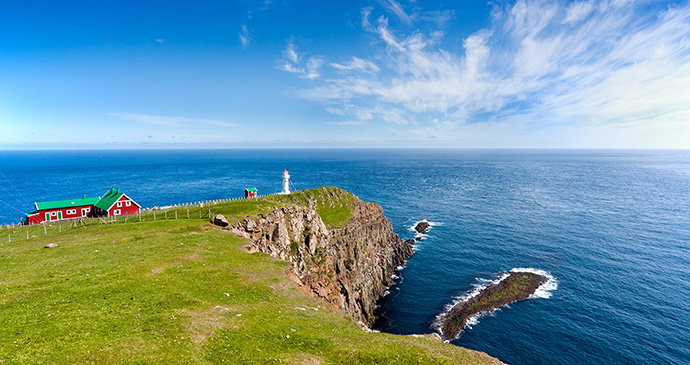
Akraberg
From Sumba, it’s barely another 2km along the road which climbs up out of the village to Akraberg and the most southerly point of the Faroe Islands. This wonderfully remote rocky promontory, which juts out proudly into the churning waves of the North Atlantic, is a suitably enigmatic spot. At the end of the road there’s a viewpoint.
During World War II, British soldiers were regularly here, maintaining the lighthouse and a radar station that scanned the sea and skies south of the Faroes; some of the pillboxes they built as part of anti-invasion preparations are still standing.
It’s thought that the original inhabitants of Akraberg were heathen Frisians who began settling here in around 800 – there are legends about them in Faroese folklore based on oral accounts which were later written down in the late 1700s. Between 700–800 they were driven north by Frankish expansion and began settling on the territories of what’s now Germany, Holland and Jutland in Denmark.
However, it’s assumed some sailed further north as old legends tell of an island north of the British Isles known as Frislandia – quite possibly Suðuroy. At its peak, there were 13 houses occupied by Frisians at Akraberg, while their (pirate) ships were moored at Sumba.
The best known of the Frisians was Hergeir, who infamously burned down Bishop Erlendur’s residence at Kirkjubøur. The Frisian population finally succumbed to the Black Death in 1350, when the last two remaining inhabitants moved to Sumba and married there. The original settlement was located down on the shoreline but has long since vanished into the sea.
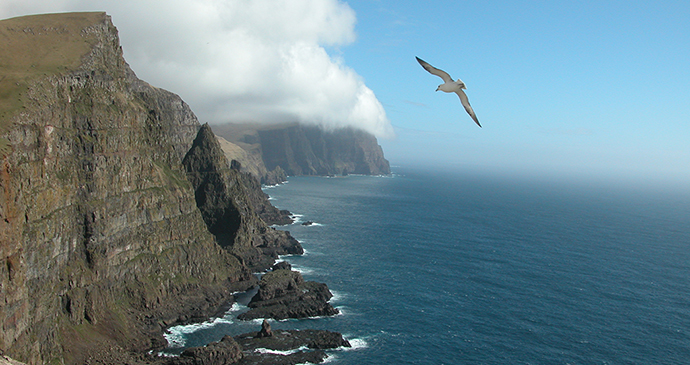
Beinisvørð cliffs
Just before the tunnel at Lopra, take the right turn signed for Víkarbyrgi to reach one of the real highlights of Suðuroy: the breathtaking, 470m-high Beinisvørð cliffs, which are the Faroes’s second-highest vertical sea cliffs.
On their eastern, landward side, the cliffs are denoted by an unbelievably steep grassy slope that soars skywards to the tip of the craggy triangular peak that marks the very highest point of Beinisvørð. From here, the cliffs plummet on their seaward side vertically into the North Atlantic below and can be seen for miles around, totally dominating any view from Lopra and Sumba (and can even be seen from the Smyril ferry as she swings in towards Tvøroyri).
Risking life and limb, generations of local men from Sumba have abseiled down the sheer cliff face in search of seabirds and their eggs, which once were an important source of food – tragically, many paid the ultimate price. Over the years, the dramatic nature of Beinisvørð has even inspired several poets, who have used the cliffs as a potent symbol of independence in their work; today they proudly feature on the Faroese 50kr banknote.
ou can get close to the cliffs on the old Lopra–Sumba road at a spot known as Hesturin (the location of a radio mast at a sharp bend in the road), from where, with care, it’s possible to walk to the cliff edge. From Beinisvørð the road then descends gradually towards the junction for Akraberg and Sumba itself.
On the western side of Sumba, there are good views of the verdant slopes of Beinisvørð from just before the tunnel entrance. Alternatively, you can view the cliffs from a distance at Eggjarnar, near Vágur.
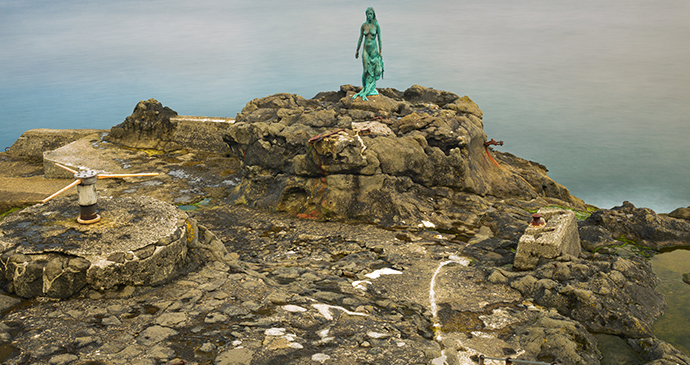
Kalsoy
The most westerly of all the northern islands, Kalsoy, weighing in at just 31km², is not only one of the easiest in the group to reach but it is also one of the most beguiling. This long slender finger of an island has the benefit of regular ferry connections to Klaksvík and some great hiking, making it a popular day-trip destination.
Like its easterly neighbour, Kunoy, this island is also composed of a single ridge of mountains, which run north to south down its centre. The peaks plummet, often perpendicularly, to the sea along the west coast, rendering it entirely inaccessible, whereas the gentler east coast, where Kalsoy’s four settlements are to be found, is characterised by a number of botnar, whose deep, rounded nature has allowed some agricultural activity to take place.
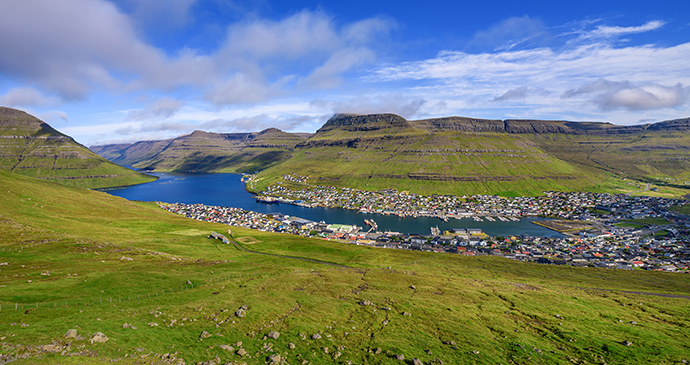
Klaksvík
Sitting snugly around a tight U-shaped inlet crammed with state-of-the-art ocean-going fishing trawlers, Klaksvík, with a population of around 4,700, is the second-largest settlement in the Faroes and the economic and administrative centre for the northern islands. It’s here that the entire population of the six surrounding islands comes to shop and go about their everyday chores, be it going to the bank, popping into the library or sorting things out at the district council.
Klaksvík owes its pre-eminence to its superbly sheltered harbour, which, ever since the town was granted municipal status in 1908, has continued to grow steadily and today is the site of one of the Faroes’s largest and most successful fish-processing plants, served by the town’s sizeable fishing fleet. Remarkably there’s also a brewery in Klaksvík: Föroya Bjór was originally established by a local farmer and has since grown into the country’s biggest and best beer producer, brewing and selling from its store classic European-style lager from imported hops from southern Denmark; the use of the ö in the spelling of the word föroya is an older version of today’s Danicised føroyar.
Although Klaksvík can trace its history back to Viking times when a ting was held here to pronounce upon all things administrative, today’s town effectively grew out of the four farms which were well established by the time a trading station was established here in 1838 during the Danish Trade Monopoly.
It wasn’t until the end of the 19th century that Klaksvík made the transition from farming to fishing and acquired the modern harbour which today provides the town with its window on the world: one-fifth of the the Faroes’s fish exports originate here.
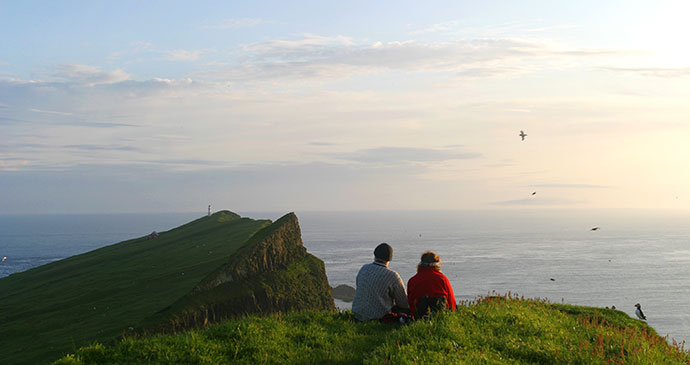
Mykines
Mykines really is something special. Geographically the Faroes’s most westerly (and driest) outpost, this rugged isle, barely 10km², is certainly the most enigmatic of the 18 Faroe Islands and the one that ranks, time and again, as the absolute favourite among Faroese and visitors alike.
Looking down the fjord from Sørvágur its craggy cliffs and hills rise precipitously out of the sea in a wall of lush green, turquoise and steely grey, the winds hurrying the clouds across the sky, changing the island’s aspect as frequently as the light.
Depending on the prevailing weather conditions, Mykines can seem bright and inviting or, at other times, sombre and threatening. Approaching across the turbulent waters of the Mykinesfjørður, which separates the island from Vágar, Mykines can appear totally inaccessible, the south coast a remarkable series of unapproachable sheer cliffs and rocky clefts. High above this wall of rock, the peak, Knúkur (560m), bears down over the eastern end of the island, from where two rocky valleys, Borgardalur and Kálvadalur, tumble down to the sea drained by several serpentine rivers.
As the land falls away to the west of the mountain, the rocky outcrops of the interior give way to a luxuriant valley of the deepest green that leads down gently to the island’s only settlement.
Some 150m below the village, hemmed into an alarmingly narrow cleft full of jagged reefs, the landing stage is regularly battered by the crashing Atlantic surf and surging waves; arrival in Mykines is not only an adventure but also something of an unpredictability, since, with southwesterly winds, the ferry may not be able to steer into the tiny harbour despite having sailed from Sørvágur with that very intention. It’s not unknown for the island to be cut off for days, even a week or so, during particularly stormy weather.
Charming though Mykines village is, it’s the tremendous profusion of summer birdlife that is the real draw here. Seemingly everywhere you look there are birds: in the air, on the cliffs and hiding in nesting burrows on the hillsides. Indeed, the western point of the island beyond the harbour, known as Lambi, is a favourite location for puffin who gather here in uncountable numbers between mid-April and mid- to late August to hatch and rear their young – Mykines is the only place in the Faroes where they are protected and cannot be hunted.
Beyond here, a narrow footbridge leads across to the neighbouring rectangular islet, Mykineshólmur, where the rock stacks, Píkarsdrangur and Flatidrangur, and surrounding cliffs are home to the Faroes’s only colony of gannets. The gannets are present between late January and October, after when the young birds migrate to Morocco for the winter, the older ones preferring to winter out at sea closer to the Faroes.
Incidentally, the correct pronunciation of the island’s name is ‘mitchiness’ and not ‘mikiness’; armed with this fact you’re bound to impress the locals.
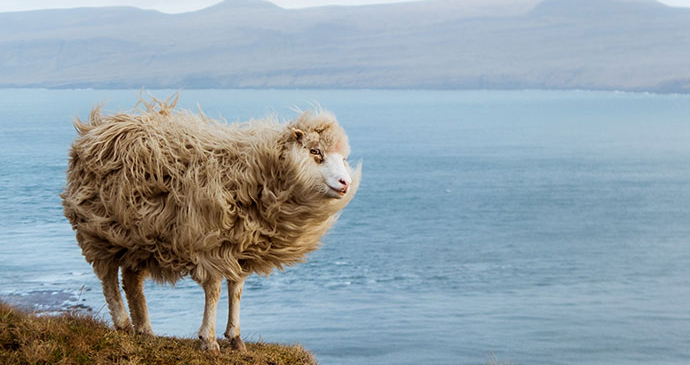
Nólsoy
A day trip to the island of is one of the most enjoyable things to do whilst visiting Tórshavn. Not only do you get a superb view of the Faroese capital from the water as the tiny ferry that sails to the island steadily chugs out of the harbour, but it’s also a chance to explore the floating humpbacked finger of land that you’ll have become distantly familiar with while in Tórshavn, as it’s an integral part of the view out to sea from all over town. Nólsoy also has the advantage of being just about the right size to tackle in a day: between ferries there’s enough time to explore the village, visit the Faroes’s most famous taxidermist to admire his stuffings and hike out through unspoilt nature to the stunningly located lighthouse on the island’s southern tip. However, should you choose to stay overnight, there’s also a chance to visit the largest colony of storm petrels anywhere in the world.
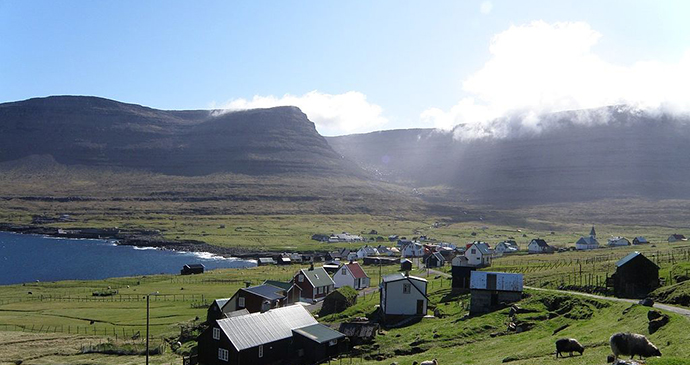
Svínoy and Fugloy
The journey that everyone who comes to the Faroe Islands wants to make is the combination of bus and ferry that leads to the country’s two most remote islands: Svínoy and Fugloy. Indeed, much of the attraction of these two last places far out in the North Atlantic lies in the getting there.
The weather in this exposed northeastern corner of the country often plays havoc with timetables and arriving here at all is a major achievement. A journey out here is not something to be undertaken on a whim; it requires careful planning, perseverance and, not least, a large amount of luck.
In a strong tide, the roughest parts of the journey will be when the boat turns out of the sheltered Hvannasund sound to pass through the narrow stretch of water, Svínoyarfjørður, between Bergið on southern Viðoy and Tangarnir on Svínoy, and particularly the final stretch across the open water of Fugloyarfjørður between Svínoy and Fugloy when the boat, quite literally, bobs like a cork.
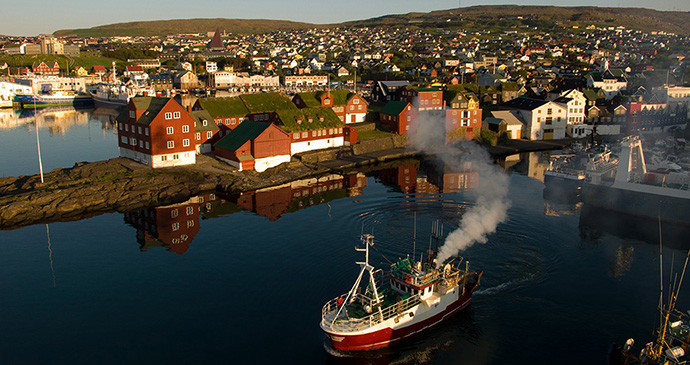
Tórshavn
Proudly named after the Norse god of war, Tórshavn (literally ‘Thor’s Harbour’) is curiously built around one of the worst natural harbours in the entire country, dangerously exposed to the gales and accompanying heavy swells of the North Atlantic.
Yet it was here, around AD900, on the rocky promontory, Tinganes, that the ting or Viking parliament first began meeting every summer to chew over matters of national importance, doing so uninterrupted until 1816; today this promontory is still the seat of the Faroese government. An annual market was also held here to coincide with the assembly, developing in the Middle Ages – with the introduction of the Trade Monopoly in 1579 – into a permanent trading place with warehouses for the importing and exporting of goods.
Although Tórshavn’s future was confirmed, population growth was slow due to restrictive land ownership laws that made farming difficult; by the beginning of the 17th century, barely 100 people lived in the settlement. In 1673 there was a further setback when a devastating fire raged across Tinganes, destroying all but two of the warehouses there.
Over the ensuing centuries growth gradually increased, helped in large part by reform of land ownership rights, and by 1900 Tórshavn’s population had soared to 15,000, tripling in just 100 years. Today, Tórshavn has finally come of age, blossoming into a self-confident, bustling medium-sized town with a population of around 19,800 people and all the trappings of a national, if diminutive, capital: government offices, parliament and foreign consulates are all here and the town is home to two out of five Faroe Islanders. Incidentally, you pronounce Tórshavn toe-ush-hown.
For orientation, take the harbour as your point of reference: from here, Tórshavn stretches in three directions: west up the steep hillsides behind the town centre that act as the capital’s backdrop, as well as both north and south curving around the waterfront. However, it is the all-important harbour, through which the country maintains contact with the rest of the world, which remains the town’s focal point and is arguably the most attractive part of town.
Here a long row of converted warehouses, with façades ranging in colour from a rich yellow ochre to bright reds and blues, reflect in the crystal-clear waters of the harbour bursting with small wooden fishing vessels; during the long summer days, the couple of cafés on the waterfront here are full of people enjoying a cup of coffee, watching the boats bob on the Atlantic swell – the classic picture-postcard view of Tórshavn.
From here a warren of narrow streets and lanes leads up and over the hill on to Tinganes, winding past tiny black-tarred houses with white window frames and green turfed roofs to the grander former merchants’ houses. Today, these are home to the various departments of the Faroese Home Rule government; they stand on the very tip of the promontory looking over to Skansin fort which once protected Tórshavn harbour from marauding pirates.
However, it is in and around the compact grid of modern streets north of Tinganes, dominated by the pedestrianised main drag, Niels Finsens gøta, where you’re likely to spend most of your time. It’s here that most of the town’s facilities are located: shops, restaurants and a bank are all to be found within a central area measuring no more than 1km² or so – Tórshavn is, after all, the smallest national capital in the world.
From the centre of town, Tinghúsvegur streaks north, past the Faroese parliament, to the SMS shopping centre and on to the forested Viðarlundin Park, one of the few plantations in the country and a favourite place for a stroll.
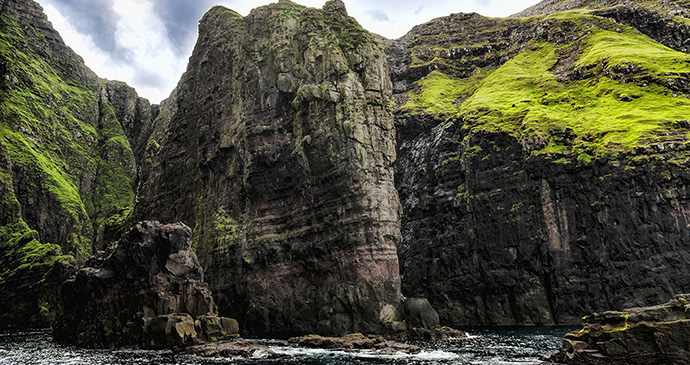
Vestmanna bird cliffs
One of the best excursions anywhere in the Faroes is a boat trip to the Vestmanna bird cliffs and grottoes. Known as the Vestmannabjørgini in Faroese, these soaring cliffs, roughly halfway between Vestmanna and Saksun to the north, provide safe nesting places during the summer months (roughly May until late August) for thousands upon thousands of seabirds, attracted by the vast shoals of fish that gather here in the plankton-rich waters of the North Atlantic.
Rising up to 600m above the turquoise hues of the churning sea below, the cliffs are characterised by their numerous clefts and green blankets of luxuriant grass and mosses.
The boats that sail out here give you an unparalleled view of the cliffs and the birds – notably puffins, razorbills and guillemots – as they weave in between the numerous sea stacks and in and out of narrow straits bound by sheer rock walls (look up and you may well see sheep grazing quite undisturbed on the clifftops) and dark echoing grottoes where the sound of the squawking birds and dripping water is amplified to unnerving proportions.
Related books
For more information, see our guide to the Faroe Islands:
Related articles
Discover the best way to see these islands while driving yourself
If you like your holidays really remote, then these are the islands for you.
Their initiative allows visitors to explore their dramatic landscapes through the eyes of a local.
